Solar eclipse of November 23, 2003
A total solar eclipse took place on November 23, 2003 with a magnitude of 1.0379. A solar eclipse occurs when the Moon passes between Earth and the Sun, thereby totally or partly obscuring the image of the Sun for a viewer on Earth. A total solar eclipse occurs when the Moon's apparent diameter is larger than the Sun's, blocking all direct sunlight, turning day into darkness. Totality occurs in a narrow path across Earth's surface, with the partial solar eclipse visible over a surrounding region thousands of kilometres wide. It was visible from a corridor in the Antarctic region. A partial eclipse was seen from the much broader path of the Moon's penumbra, including the southern tip of South America and most of Australia.
| Solar eclipse of November 23, 2003 | |
|---|---|
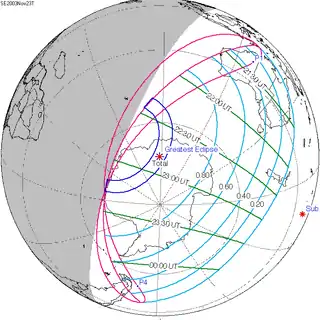 Map | |
| Type of eclipse | |
| Nature | Total |
| Gamma | -0.9638 |
| Magnitude | 1.0379 |
| Maximum eclipse | |
| Duration | 117 sec (1 m 57 s) |
| Coordinates | 72.7°S 88.4°E |
| Max. width of band | 495 km (308 mi) |
| Times (UTC) | |
| Greatest eclipse | 22:50:22 |
| References | |
| Saros | 152 (12 of 70) |
| Catalog # (SE5000) | 9516 |
For most solar eclipses the path of totality moves eastwards. In this case the path moved south and then west round Antarctica.
Images
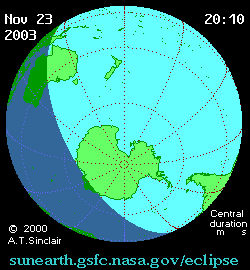
Animated map
Related eclipses
Eclipses of 2003
Solar eclipses 2000–2003
This eclipse is a member of a semester series. An eclipse in a semester series of solar eclipses repeats approximately every 177 days and 4 hours (a semester) at alternating nodes of the Moon's orbit.[1]
Note: Partial solar eclipses on February 5, 2000 and July 31, 2000 occur in the previous lunar year set.
| Solar eclipse series sets from 2000–2003 | ||||||
|---|---|---|---|---|---|---|
| Ascending node | Descending node | |||||
| Saros | Map | Gamma | Saros | Map | Gamma | |
| 117 | 2000 July 1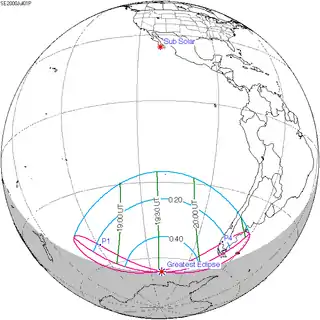 Partial (south) | -1.28214 | 122 | 2000 December 25 Partial (north) | 1.13669 | |
127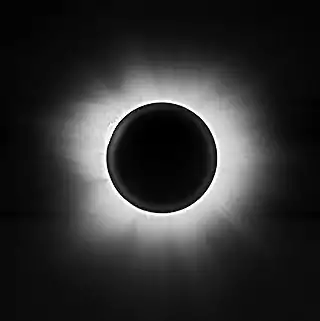 Totality from Lusaka, Zambia | 2001 June 21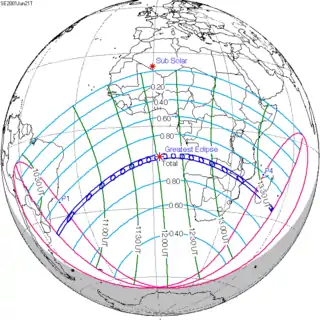 Total | -0.57013 | 132 Partial from Minneapolis, MN | 2001 December 14 Annular | 0.40885 | |
137.jpg.webp) Partial from Los Angeles, CA | 2002 June 10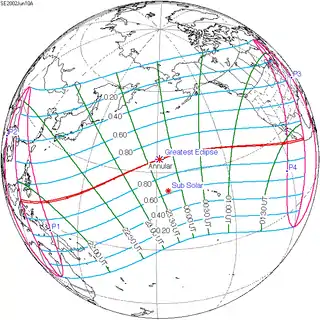 Annular | 0.19933 | 142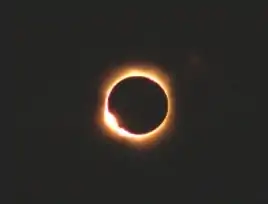 Totality from Woomera | 2002 December 4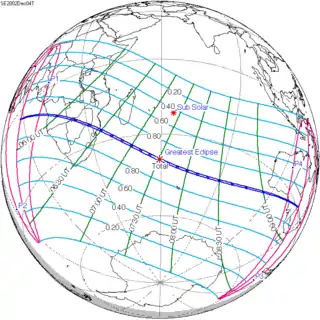 Total | -0.30204 | |
147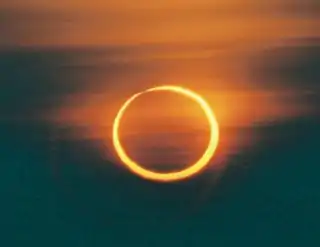 Culloden, Scotland | 2003 May 31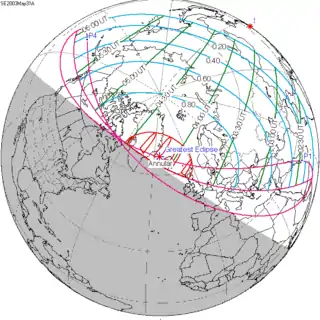 Annular | 0.99598 | 152 | 2003 November 23 Total | -0.96381 | |
Saros 152
Solar saros 152, repeating every about 18 years and 11 days, contains 70 events. The series started with a partial solar eclipse on July 26, 1805. It has total eclipses from November 2, 1967, to September 14, 2490; hybrid eclipses from September 26, 2508, to October 17, 2544; and annular eclipses from October 29, 2562, to June 16, 2941. The series ends at member 70 as a partial eclipse on August 20, 3049. The longest total eclipse will occur on June 9, 2328, at 5 minutes and 15 seconds; the longest annular eclipse will occur on February 16, 2743, at 5 minutes and 20 seconds.[2]
| Series members 7–17 occur between 1901 and 2100: | ||
|---|---|---|
| 7 | 8 | 9 |
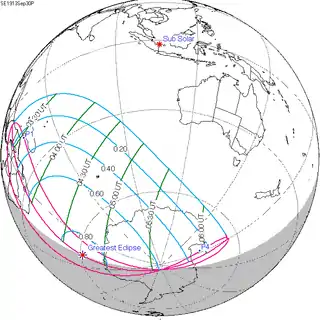 September 30, 1913 |
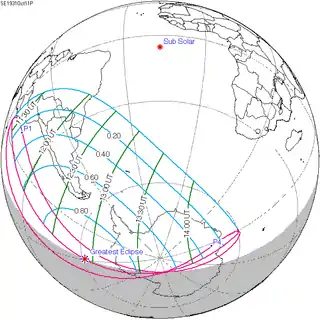 October 11, 1931 |
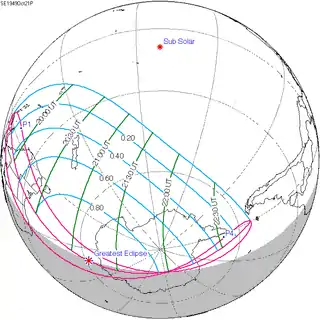 October 21, 1949 |
| 10 | 11 | 12 |
 November 2, 1967 |
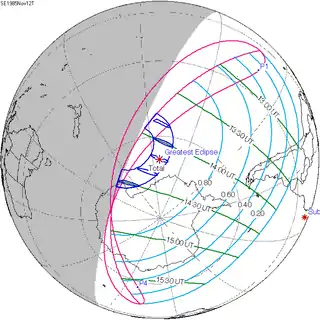 November 12, 1985 |
 November 23, 2003 |
| 13 | 14 | 15 |
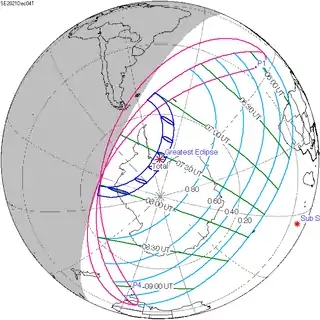 December 4, 2021 |
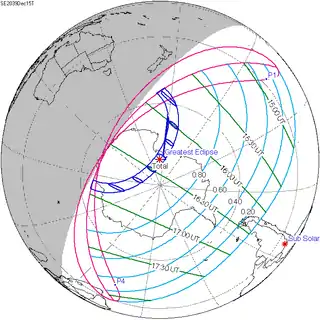 December 15, 2039 |
 December 26, 2057 |
| 16 | 17 | |
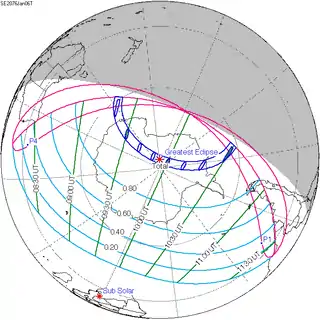 January 6, 2076 |
 January 16, 2094 | |
Metonic series
The metonic series repeats eclipses every 19 years (6939.69 days), lasting about 5 cycles. Eclipses occur in nearly the same calendar date. In addition, the octon subseries repeats 1/5 of that or every 3.8 years (1387.94 days). All eclipses in this table occur at the Moon's descending node.
| 22 eclipse events between September 12, 1931 and July 1, 2011. | ||||
|---|---|---|---|---|
| September 11-12 | June 30-July 1 | April 17-19 | February 4-5 | November 22-23 |
| 114 | 116 | 118 | 120 | 122 |
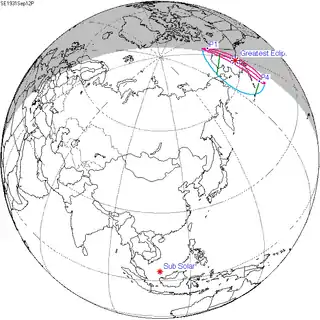 September 12, 1931 |
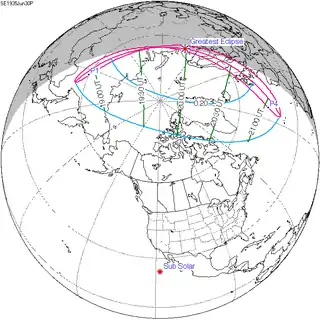 June 30, 1935 |
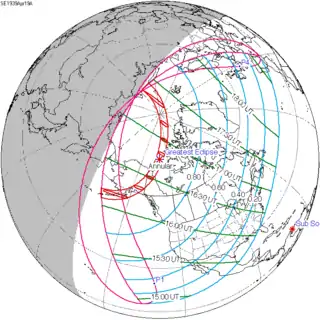 April 19, 1939 |
 February 4, 1943 |
 November 23, 1946 |
| 124 | 126 | 128 | 130 | 132 |
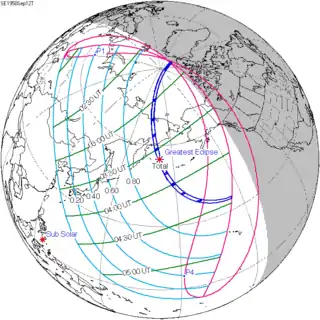 September 12, 1950 |
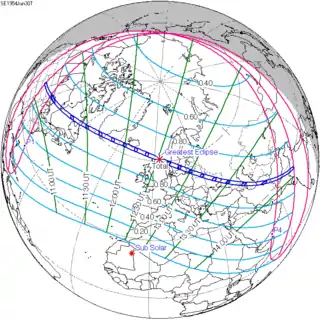 June 30, 1954 |
 April 19, 1958 |
 February 5, 1962 |
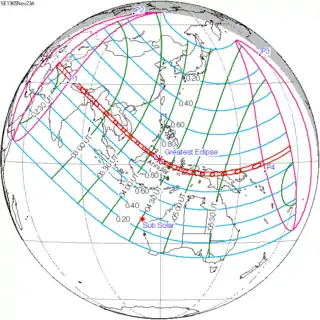 November 23, 1965 |
| 134 | 136 | 138 | 140 | 142 |
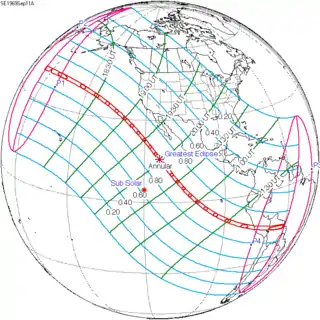 September 11, 1969 |
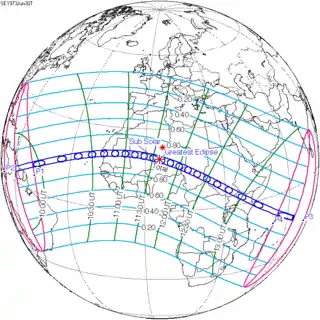 June 30, 1973 |
 April 18, 1977 |
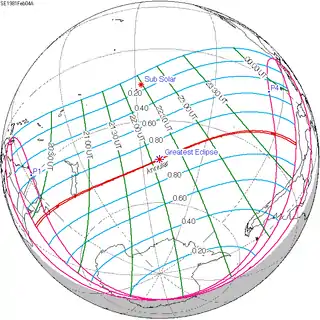 February 4, 1981 |
 November 22, 1984 |
| 144 | 146 | 148 | 150 | 152 |
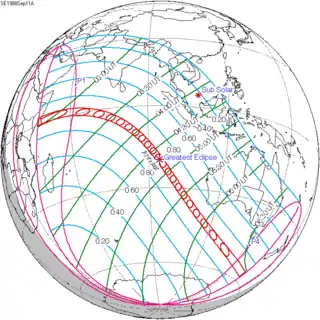 September 11, 1988 |
 June 30, 1992 |
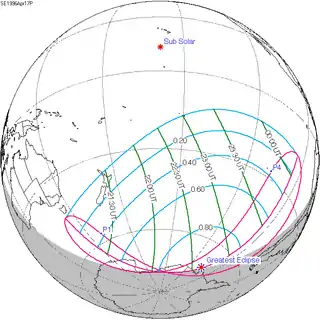 April 17, 1996 |
 February 5, 2000 |
 November 23, 2003 |
| 154 | 156 | 158 | 160 | 162 |
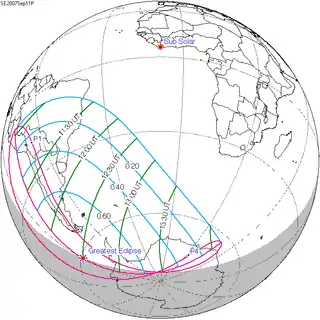 September 11, 2007 |
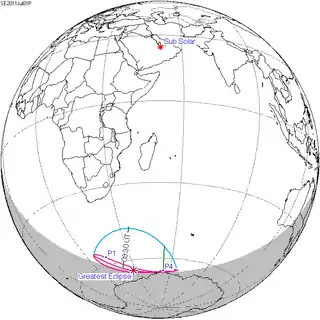 July 1, 2011 |
April 18, 2015 | February 4, 2019 | November 23, 2022 |
Notes
- van Gent, R.H. "Solar- and Lunar-Eclipse Predictions from Antiquity to the Present". A Catalogue of Eclipse Cycles. Utrecht University. Retrieved 6 October 2018.
- Saros Series Catalog of Solar Eclipses NASA Eclipse Web Site.
References
- Fred Espenak and Jay Anderson. "Total Solar Eclipse of 2003 November 23". NASA, July 2003.
- Earth visibility chart and eclipse statistics Eclipse Predictions by Fred Espenak, NASA/GSFC
- Google Map
Photos:
- Prof. Druckmüller's eclipse photography site. Flight over Antarctica
- Images from Antarctica by Crayford Manor House Astronomical Society
- APOD 8/5/2004, An Antarctic Total Solar Eclipse
- APOD 11/27/2003, The Long Shadow of the Moon, Total solar eclipse from satellite over Antarctica
.jpg.webp)

